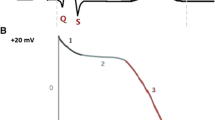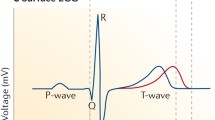Abstract
Many drugs are cardiotoxic because they inhibit hERG K+ channels, thus prolonging the repolarization phase of the cardiomyocyte action potential giving rise to cardiac arrhythmias. Early detection of inhibiting effects of candidate drugs on the activity of K+ channels in cardiomyocytes is one of the main challenges in preclinical drug screening. The aim of this study was to obtain a cell line expressing recombinant hERG channels at a stable and reproducible level as a prerequisite to its further application as a test system.
Similar content being viewed by others
References
Brown, A.M., Drugs, hERG and Sudden Death, Cell Calcium, 2004, vol. 35, pp. 543–547.
Nattel, S., Maguy, A., Le Bouter, S., and Yeh, Y.-H., Arrhythmogenic Ion-Channel Modeling in the Heart: Heart Failure, Myocardial Infarction, and Atrial Fibrillation, Physiol. Rev., 2007, vol. 87, pp. 425–456.
Sanguinetti, M.C. and Tristani-Firouz, M., hERG Potassium Channels and Cardiac Arrhythmia, Nature, 2006, vol. 440, pp. 463–469.
Lankipalli, R.S., Zhu, T., Guo, D., and Yan, G.-X., Mechanisms Uderlying Arrhythmogenesis in Long QT Syndrome, J. Electrocardiol., 2005, vol. 38, pp. 69–73.
Marban, E., Cardiac Channelopathies, Nature, 2002, vol. 415, pp. 213–218.
Sanguinetti, M.C., Jiang, C., Curran, M.E., and Keating, M.T., A Mechanistic Link between an Inherited and an Acquired Cardiac Arrhythmia: HERG Encodes the IKr Potassium Channel, Cell, 1995, vol. 81, pp. 299–307.
Trudeau, M.C., Warmke, J.W., Ganetzky, B., and Robertson, G.A., hERG a Human Inward Rectifier in the Voltage-Gated Potassium Channel Family, Science, 1995, vol. 269, pp. 92–95.
Snyders, D.J. and Chaudhary, A., High Affinity Open Channel Block by Dofetilide of HERG Expressed in a Human Cell Line, Mol. Pharmacol., 1996, vol. 49, pp. 949–955.
Spector, P.S., Curran, M.E., Keating, M.T., and Sanguinetti, M.C., Class III Antiarrhythmic Drugs Block HERG, a Human Cardiac Delayed Rectifier K+ Channel. Open-Channel Block by Methanesulfonanilides, Circ. Res., 1996, vol. 78, pp. 499–503.
Mohammad, S., Zhou, Z., Gong, Q., and January, C.T., Blockage of the HERG Human Cardiac K+ Channel by the Gastrointestinal Prokinetic Agent Cisapride, Am. J. Physiol. Heart. Circ. Physiol., 1997, vol. 273, pp. 2534–2538.
Simons, F.E., Kesselman, M.S., Giddings, N.G., Pelech, A.N., and Simons, K.J., Astemizole-Induced Torsades De Pointes, Lancet, 1988, vol. 2, p. 624.
Woosley, R.L., Chen, Y., Freiman, J.P., and Gilles, R.A., Mechanism of the Cardiotoxic Actions Terfenadine, JAMA, 1993, vol. 269, pp. 1532–1536.
Ball, P., Mandell, L., Niki, Y., and Tillotson, G., Comparative Tolerability of the Newer Fluoroquinolone Antibacterials, Drug. Saf., 1999, vol. 21, pp. 407–421.
Iannini, P., Doddamani, S., Byazrova, E., Curciumaru, I., and Kramer, H., Risk of Torsades De Pointes with Non-Cardiac Drugs. Prolongation of QT Interval Is Probably a Class Effect of Fluoroquinolones, BMJ, 2001, vol. 322, pp. 46–47.
Ball, H.L, Myers, J.S., and Cortez, D., ATRIP Binding to Replication Protein A-Single-Stranded DNA Promotes ATR-ATRIP Localization but Is Dispensable for Chk1 Phosphorylation, Mol. Biol. Cell, 2005, vol. 16, pp. 2372–2381.
Kolesnikov, S.S. and Margolskee, R.F., Extracellular K+ Activates a K+-and H+-Permeable Conductance in Frog Taste Cells, J. Physiol., 1998, vol. 507, pp. 415–432.
Vandenberg, J.I., Torres, A.M., Campbell, T.J., and Kuchel, P.W., The HERG K+ Channel: Progress in Understanding the Molecular Basis of Its Unusual Gating Kinetics, Eur. Biophys. J., 2004, vol. 33, pp. 89–97.
Lin, G.X., Zhou, J., Nattek, S., and Koren, G., Single-Channel Recording of a Rapid Delayed Rectifier Current in Adult Mouse Ventricular Myocytes: Basic Properties and Effects of Divalent Cations, J. Physiol., 2004, vol. 556, pp. 401–413.
Author information
Authors and Affiliations
Corresponding author
Additional information
Original Russian Text © A.A. Shutov, O.V. Lebedeva, R.A. Romanov, O.A. Rogachevskaya, N.V. Kabanova, S.S. Kolesnikov, E.R. Safarova, 2008, published in Biologicheskie Membrany, 2008, Vol. 25, No. 4, pp. 301–307.
Rights and permissions
About this article
Cite this article
Shutov, A.A., Lebedeva, O.V., Romanov, R.A. et al. A cellular test system expressing hERG K+ channels for assaying drug cardiotoxicity: Elaboration and analysis. Biochem. Moscow Suppl. Ser. A 2, 253–258 (2008). https://doi.org/10.1134/S1990747808030094
Received:
Published:
Issue Date:
DOI: https://doi.org/10.1134/S1990747808030094




